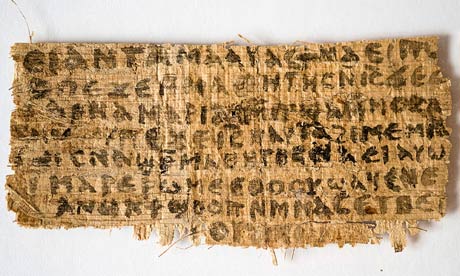 If you have been following the news recently, you may have heard about the recently uncovered Coptic text which may indicate a belief in early Christianity that Jesus had a wife. This fragment of papyrus from the second century, appears to be a sacred text along with similar texts like the Gospel of Judas, the Gospel of Mary Magdalene, and the Gospel of Thomas that did not make the traditional canon of Christianity but seem to display an alternative interpretation of the life and ministry of Jesus.
If you have been following the news recently, you may have heard about the recently uncovered Coptic text which may indicate a belief in early Christianity that Jesus had a wife. This fragment of papyrus from the second century, appears to be a sacred text along with similar texts like the Gospel of Judas, the Gospel of Mary Magdalene, and the Gospel of Thomas that did not make the traditional canon of Christianity but seem to display an alternative interpretation of the life and ministry of Jesus.There are many questions that have risen as a result of this finding, everything from "who are Coptic Christians?" to what kind of authority this text has. Some have argued that if Jesus had a wife who was his disciple, this would open up all kinds of possibilities for women in leadership in the church which many denominations have so far denied them.
I want to outline a little historical perspective on this issue and then offer an alternative opinion, that I believe our obsession with Jesus having a wife actually is an attempt to domesticate Jesus and keep women in a subordinate position to men. I believe that a celibate Jesus, who calls women and men to discipleship, helps us see a more true equality between genders than a married Jesus would.
Coptic Christians
 Who are Coptic Christians? This question has led me back into my church history textbooks, which has been a healthy intellectual exercise this week. It is a confusing history, but the emergance of Coptic Christians goes back to the fourth century and a debate in eastern Christianity around the full humanity and full divinity of Jesus.
Who are Coptic Christians? This question has led me back into my church history textbooks, which has been a healthy intellectual exercise this week. It is a confusing history, but the emergance of Coptic Christians goes back to the fourth century and a debate in eastern Christianity around the full humanity and full divinity of Jesus.In the western Church, most Christians affirmed the paradoxical statement of Tertullian, that in Christ there were two natures united in one person. In the eastern church, however, there was a desire to spell this out a litle more fully.
This resulted in to primary "schools" of thought regarding the humanity and divinity of Jesus. There were the Alexandrines, who thought a primary emphasis should be on Jesus as a teacher of divine truth. Because of this emphasis, the divinity of Jesus is the primary lens through which we should understand his person. Antiochenes, however, felt that in order for Jesus to be the savior, for his death to have significance for our lives, he had to be fully human, fully part of our condition and life. They felt the Alexandrine diminished this full humanity of Jesus.
 |
| Eutyches |
This greatly upset the Patriach of Constantinople, Flavian, who was strongly Antiochene (emphasis on the humanity of Jesus) and thought Eutyches was preaching something close to docetism (a heresy that states that Christ has two natures that do not unite in the one person). Eutyches was thus condemned as a heretic.
In the end, the eastern church resolved their conflict with the "Definition of faith," that ultimately placed them back in the orthodoxy of the western tradition, that Christ is fully human and fully God, two natures united in one person, distinct yet not separated.
There were dissenters in this movement, however, some of whom wanted to emphasize the unity of Jesus over his two natures. These became known as "monophysites" (from mono = one and physis = nature). In the Byzantine Empires, the strongholds fro monophysism were in Egypt and Syria, where the oldest natural Egyptians, the Copts, were oppressed by the empire. This mix of nationalism and theology came to form the Coptic Church in Egypt, a monophysite tradition.
Today the Coptic Church has between 12 and 18 million members, and ten percent of Egyptian citizens belong to this church.
Where does this scrap of Papyrus come from?
From my research this text is dated back to the fourth century AD and seems to be in a similar tradition to texts we refer to as the Gnostic Gospels. Gnosticism was an expression of Christianity that arose within the first hundred years of the church and was ultimately rejected. Gnosticism wanted to focus the faith on a "secret knowledge" that Christ comes to reveal.
There is a large amount of Platonic dualism that separates a pure soul from the wicked body. Because of this, the bodily death and resurrection of Jesus becomes less important than the wisdom he sought to dispel. True faith, then, is coming to understand that knowledge.
This expression was rejected because it seemed to minimize the role of the cross and scale back the cost of bodily discipleship that the canonized Gospels profess.
Does Jesus having a wife help women in the church?
 |
| Dr. Gail Streete |
Dr. Streete made a proposal to our class that I tend to support and believe as well. Her argument was that it is our modern reading of the scripture that makes us want Jesus to have a wife because we cannot conceive of a full human being not driven by sexual impulse. We cannot conceive of a man and woman in a mutual relationship without a desire for sex being a primary factor.
Dr. Streete argued that this sexualized interpretation of Jesus actually does more to harm the role of women in the church than to enhance their leadership because it objectifies them as sexual objects. It is almost as if we cannot comprehend that possibly Jesus called these women (Mary Magdalene, sisters Mary and Martha, etc.) to be disciples alongside the twelve named apostles. We don't sexualize Jesus' relationship with Peter, James, and John so why do we sexual his relationship with female disciples?
I believe, however, that if we want to raise the role of women to greater equality in discipleship, we have to begin to think of the women in the New Testament as full disciples and not sexual objects. I know it is sometimes hard to think that maybe Jesus wasn't as obsessed with sex as we are. I think Jesus' life was a testimony to a new kind of family relationship he was forming in the church, and I believed he called both women and men into the fullness of that mission and ministry.
As a result, I do not put too much stock in this papyrus as some kind of revolutionary discovery for the Christian religion. I think it is interesting to make note of it. I believe a thorough study of our past is a good thing. I just believe this is a more sensational response to this story than might be warranted in the larger picture of the history of Christian thought.

No comments:
Post a Comment